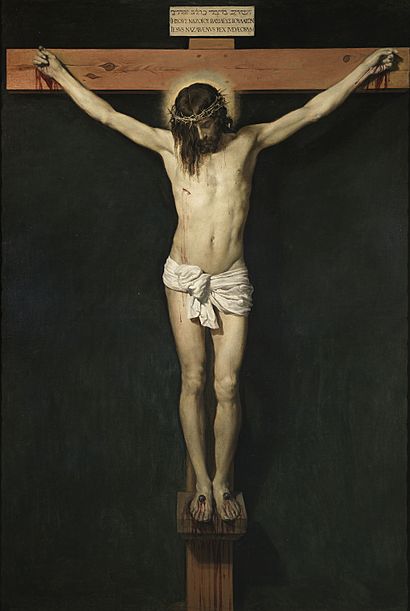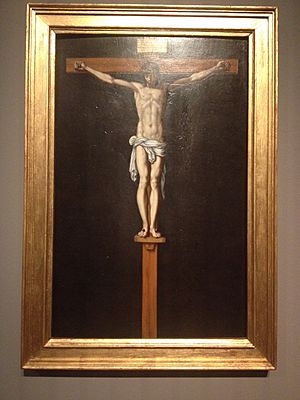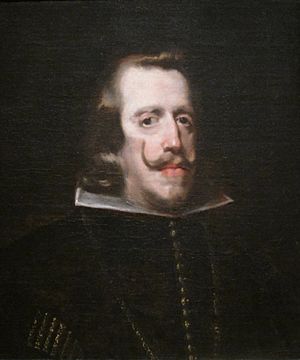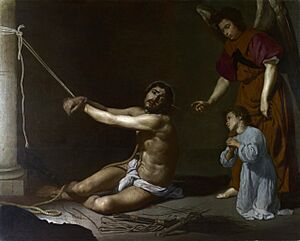Christ Crucified (Velázquez) facts for kids
Quick facts for kids Christ Crucified |
|
|---|---|
 |
|
| Artist | Diego Velázquez |
| Year | 1632 |
| Medium | oil on canvas |
| Dimensions | 249 cm × 170 cm (98 in × 67 in) |
| Location | Museo del Prado, Madrid |
Christ Crucified is a famous painting from 1632 by Diego Velázquez. It shows Jesus on the cross. Velázquez painted it using oil on canvas. The painting is very large, measuring about 249 by 170 centimeters. Today, you can see it at the Museo del Prado in Madrid, Spain.
Contents
What the Painting Shows
In the painting, Jesus's arms are gently curved, not forming a sharp triangle. His loincloth (the cloth around his waist) is small. This helps show more of his body.
Jesus's head rests on his chest. You can just see his face. His long, straight hair covers much of his face. This might hint that he has already died. A wound is visible on his right side.
This painting is different from many other Baroque paintings. Baroque art often has a lot of drama. But Velázquez's painting is calm. This calm feeling comes from the influence of Classicist painting. You can see it in Jesus's peaceful body, perfect face, and leaning head.
However, the painting also uses strong light and shadow. This style is called chiaroscuro, and it comes from Caravaggism. The background is dark, but Jesus's body and the cross are brightly lit. It looks like light is coming from Jesus himself. His body looks well-proportioned. His feet are separate and open, making him seem more at rest than dead.
How Jesus is Pictured
Velázquez followed the common way of showing Jesus on the cross in the 1600s. His teacher, Francisco Pacheco, liked classicist painting. Pacheco painted Christ with four nails, not three. He showed Jesus's feet together, resting on a small wooden support. This pose is called a contrapposto.
Pacheco's way of painting Jesus became a model for other artists. These included Velázquez, Francisco de Zurbarán, and Alonso Cano. In many other paintings of the crucifixion, Jesus's feet are pierced by one nail, with one foot over the other. But in Velázquez's painting, both feet are pierced by separate nails.
Pacheco believed Jesus was crucified with a nail in each foot. This idea caused some debate at the time. Pacheco and his friends, many of whom were Jesuits, studied old writings. They used ideas from writers, church leaders, and mystics to support their view. Some people thought Pacheco's ideas might be different from what the Bible said.
History of the Painting
We don't know the exact date Velázquez painted Christ Crucified. But historians think he made it between 1632 and 1638. This was after he came back from a trip to Italy.
It's hard to track where the painting has been. Many copies were made, especially for funeral cards and religious stamps. We do know the painting was likely in a chapel. This was at the Benedictine convent of San Placido in Madrid. It was probably given to the convent by Jerönimo de Villanueva. He was an important secretary for King Phillip IV.
Velázquez was not known for painting many religious scenes. He mostly painted portraits. But King Phillip IV encouraged him to paint more historical, religious, and mythological works. These types of paintings were seen as more important back then.
Velázquez painted many portraits for King Phillip IV. He painted the king, his family, and people who worked for him. King Phillip IV once said Velázquez worked slowly. But he thought Velázquez's art was amazing. The king introduced Velázquez to his royal court. This gave the artist new chances and resources.
Because of King Phillip IV's influence, Velázquez became good at religious and mythological art. He also made many studies of nude figures. He used these studies in later paintings. Examples include Apollo at the Forge of Vulcan (1630) and Joseph's Tunic (1630). Art experts say the nude study for Christ Crucified is special. It shows peace, dignity, and nobility. It is a life-size painting of a nude body, without a story around it.
Why This Painting Was Important
The Counter-Reformation was a time when the Catholic Church became stronger. This happened after the Protestant Reformation. The Catholic Church used sacred art to show the glory of faith. It also showed the fear for those who did not believe. The goal was to remind people of old stories and truths through art.
Velázquez's religious paintings, especially those about the Passion of Jesus, were very influential. The Passion is the time before Jesus Christ's death. It includes events like the Last Supper, Jesus's arrest, his crucifixion and death, and his burial.
At the Last Supper, Jesus said that bread and wine would represent his body and blood. After his crucifixion, followers would eat bread and drink wine. This was done in remembrance of Jesus, often called communion or Transubstantiation. Because of this, the idea of Christ's body became very important.
In Velázquez's painting of the crucifixion, Christ's body was very powerful for believers. They felt the painting would inspire them to praise God.
Legacy of the Painting
The deep spiritual feeling of this painting has inspired many religious writings. One famous example is the poem El Cristo de Velázquez. It was written by the Spanish writer and philosopher Miguel de Unamuno.
See also
 In Spanish: Cristo crucificado (Velázquez) para niños
In Spanish: Cristo crucificado (Velázquez) para niños
- List of works by Diego Velázquez




